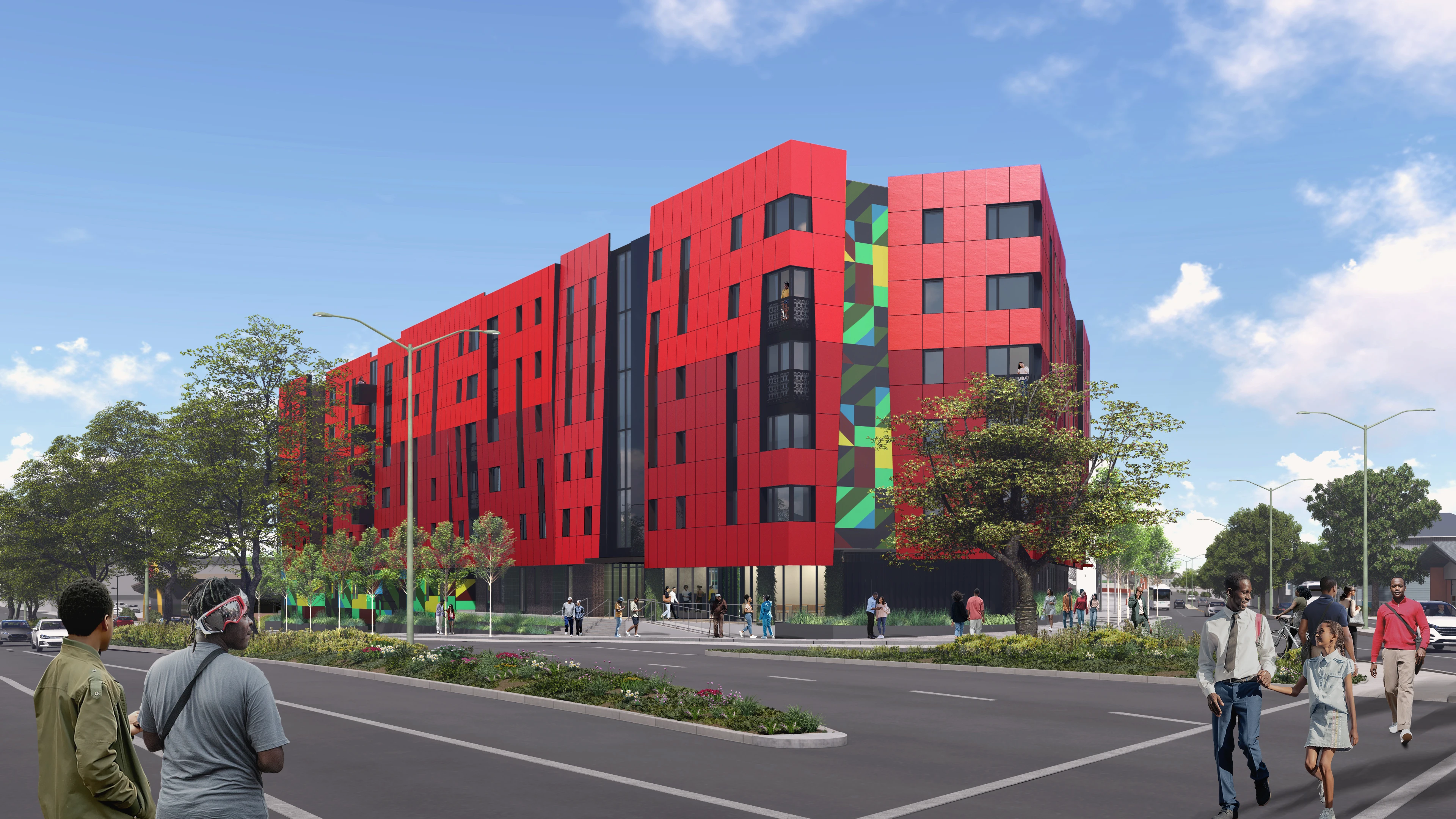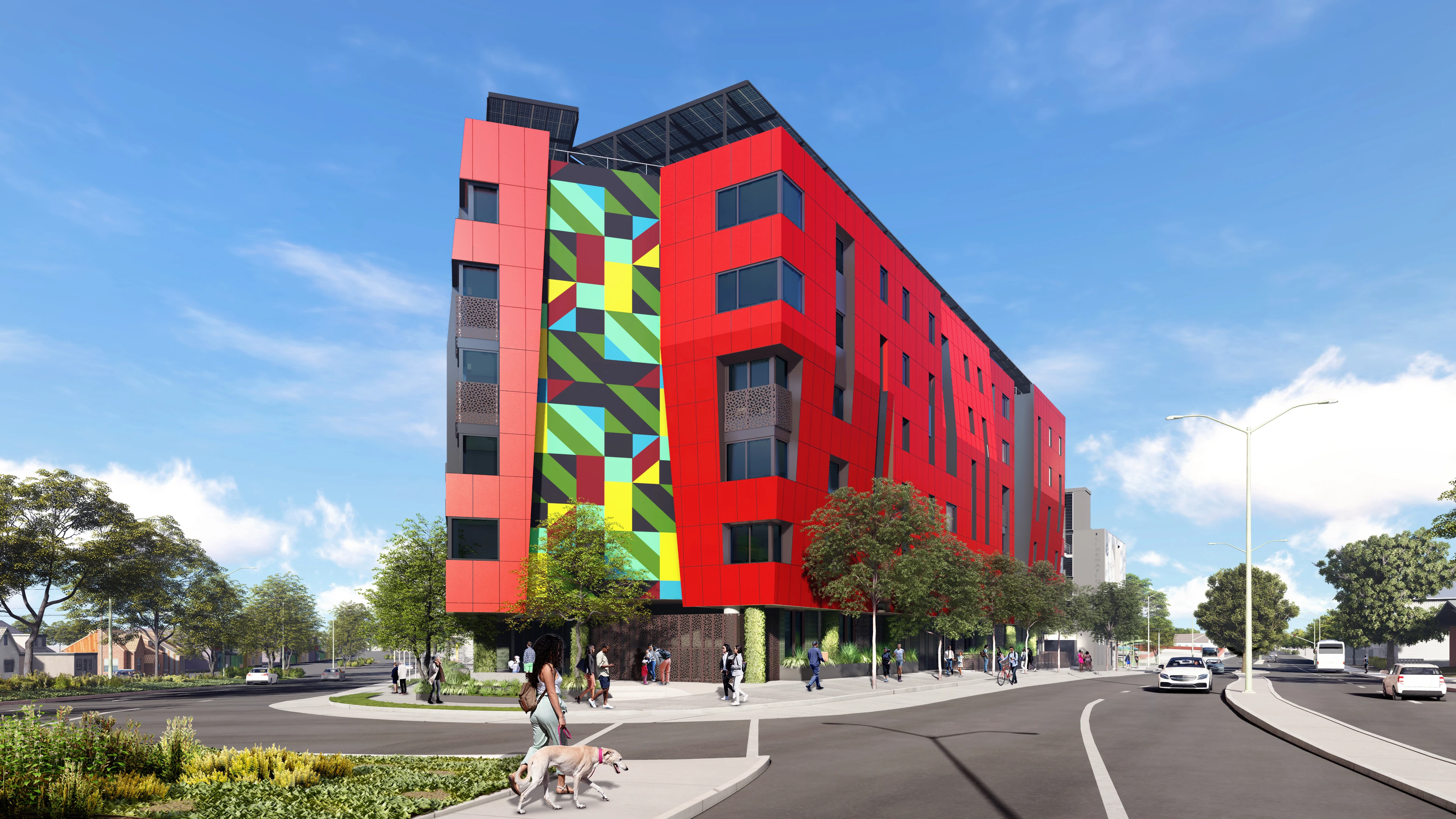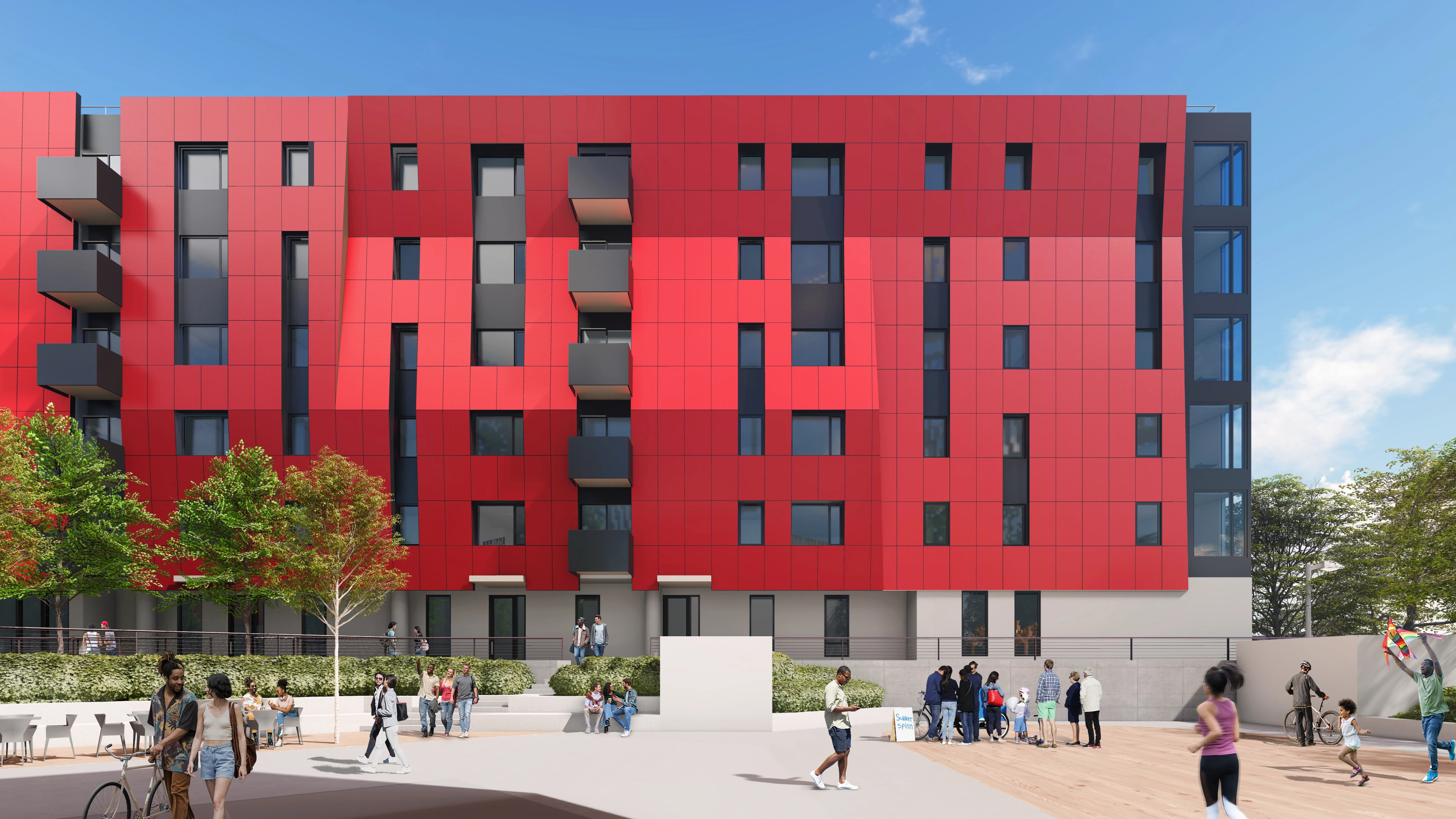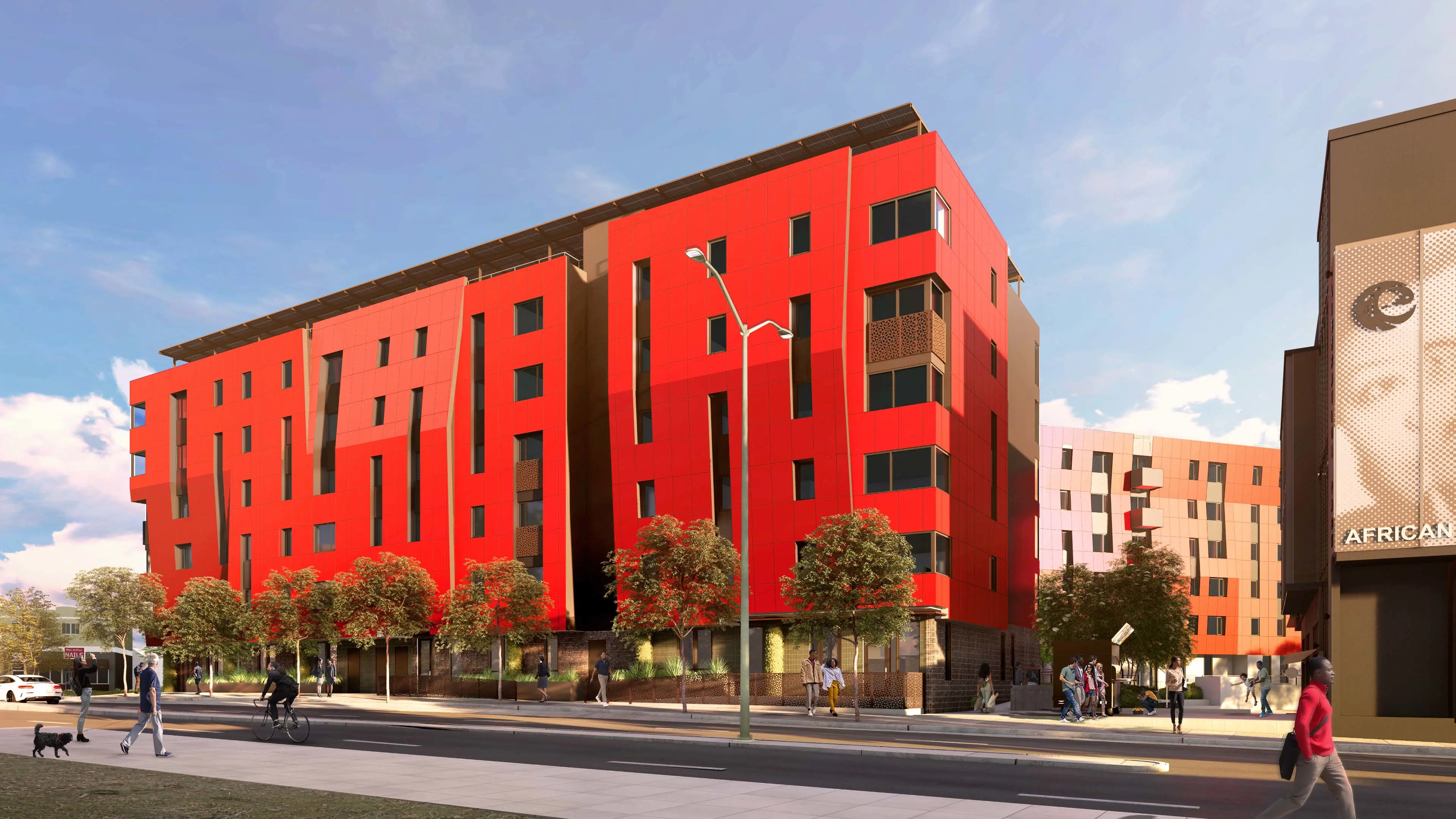& Construction

Integrated BIM tools, including Revit, AutoCAD, and Civil 3D
& Manufacturing

Professional CAD/CAM tools built on Inventor and AutoCAD
To build on the success of a temporary community park on City of Oakland-owned surplus land, Y.A. studio designed a dynamic blend of residences, a market, and indoor and outdoor spaces—all through a lens of equitable sustainability.
Liberation Park was already a success story before any buildings were designed: a city-owned surplus lot that community members remade as an outdoor market. But could Liberation Park take the next step by adding architecture without trampling the grassroots success?
That was the challenge for Y.A. studio, which planned the Liberation Park Market Hall and Residences (as the two-building development will be known) and designed its 119-unit multifamily apartments in Oakland, California. It was an opportunity for this Black and woman-owned San Francisco firm to lead a large-scale, affordable housing project and to bring healthy, sustainable design to an underserved population. Yet the designers also wanted to preserve Liberation Park’s existing spirit.
“It's the heart of the community,” says Yakuh Askew, principal, Y.A. studio. “Now we want to take that next step to ensure its longevity. The Black community in this area has been under-resourced. This is an opportunity to correct some of the wrongs.”
Autodesk Revit and Autodesk BIM Collaborate Pro enabled the project’s design and its sustainability focus—all with the flexibility and compatibility to incorporate a variety of related digital tools. The software also helped Y.A. studio continuously interact with community stakeholders by sharing renderings and ideas. Like the place that inspired it, the Liberation Park Market Hall and Residences are all about connection and creativity.
After nearly a decade at Bay Area architecture firms, Askew founded Y.A. studio in 2005, hoping to bring good design to underserved populations. After a supporting role for numerous affordable housing projects over the past decade, Y.A. studio landed the opportunity to lead the design of Oakland’s Liberation Park Affordable Housing development.
While his initials form the firm’s name, Askew draws from a diverse design team. Askew’s wife, interior designer Martine Paquin, heads her own San Francisco interiors firm, Martine Paquin Design, which focuses on high-end residential projects. But Paquin is also a longtime principal at Y.A. studio, making the firm adept at both big-picture architectural thinking and carefully crafted design details.
“When we work on affordable housing, we can still work to apply a lot of these design concepts even with a more limited budget and get to a great design,” Paquin says.
Liberation Park is a 1.2-acre triangularly shaped site where multiple thoroughfares meet and is beside the once-bustling Eastmont Mall. To address East Oakland’s disinvestment, a consortium of nonprofits created the Black Cultural Zone in 2014. It’s a 50-block redevelopment celebrating the neighborhood’s Black history while emphasizing arts and culture. In 2019, the BCZ founded Liberation Park, making this forgotten surplus lot a town square of sorts and showing what was possible.
“They built the community first,” Askew says. “I think most people probably never even knew this corner was there because you come by it so quickly. There was really no reason to walk there until Liberation Park began to take shape. But the energy it brought created a justification for putting architecture there and making it permanent.”
The design team made a priority of communicating with community throughout the process. “A lot of the design ideas we pursued came directly from our meetings with community groups,” Askew says. “We went out to the marketplaces with renderings of our designs and said, ‘What resonates with you? And how can we best reflect the community that's already here?’”
The community made one thing clear. “They did not want this building to be shy,” says Maria Carriero, associate architect, Y.A. studio. “They wanted the architecture to be proud and to reference the great work being done here.”
The Liberation Park Residences’ dynamic façade with its undulating metal panels is meant to be a canvas for local murals and art. “We want local artists to come in and put their stamp on this, not just on the façade but creating smaller opportunities at the pedestrian level,” Carriero says. “The project really tries to use art as its gravitational pull, as this incredible canvas and foundation for Black art.” Eight ground-floor units are designed to function as live-work spaces, enabling artists, artisans, and entrepreneurs to create and sell their work.
Beside the Residences will be the Black Cultural Zone Marketplace and Hub, designed by blink!Lab Architecture. A courtyard between the two buildings and substantial outdoor plantings around the perimeter help encourage people to linger.
“The ground floor is really intended to be this very public space, and very transparent,” Askew says. “As you're walking in, you're immediately seeing the greenery in the back and the public community spaces, and that was really important. We don't want the building to be overpowering. It should be a canvas for the community to inhabit it and make their own. But it also needs to have its own strength. That was a tricky balance all the way along.”
The Liberation Park Residences units are reserved for households earning 20-60 percent of the median Alameda County income. The design prioritized healthy interior spaces for a predominantly Black population disproportionately impacted by climate change and pollution. “People are entitled not only to a home, but a healthy home,” Askew says.
Part of health is resilience, which is why the project is equipped with solar panels that can help keep power partially on during a grid failure. But indoor air quality was a particular focus. “The mechanical systems for the units have great filtered air for all the residents, which is important given given how many smoke-filled days we have during what’s become a recurring wildfire season in the fall,” Askew says. “There's a lot of vehicular traffic here, so that’s all the more reason making sure that our residents are getting filtered, clean air 24-7 is pretty key for this site.”
The Y.A. studio team also pursued numerous sustainability grants related to infrastructure, enabling wider new sidewalks, planters, and bike lanes to calm traffic and improve air quality. Combined with the development’s new courtyard, “I think for the residents, it'll feel like they have quite a bit of access to their own public open area,” says Yu Tsuji, associate architect, Y.A. studio.
To create the Liberation Park Residences’ kinetic façade, Y.A. studio experimented with several variations using multiple tools. “We developed the facade shape a lot in Rhino, refining and refining,” Carriero says. “Bringing that into our Revit model, it was very easy to turn that theoretical shape into real walls and start thinking from a constructability perspective. The ability to go back and forth from play space to documentation space was really useful.”
Sharing renderings helped the architects gain valuable feedback. They used Enscape for live rendering to test ideas and Autodesk 3ds Max to communicate the project’s possibility to the community with polished renderings, both incorporated into Revit. “Because we were talking so much about the effect of these graphic elements on the facade, it was really important for us to start seeing what effect it had on the street and how you experienced it as a pedestrian and as a driver,” Carriero explains.
Revit’s compatibility with other file formats also helped enable equity. “The owners really wanted ‘to walk the walk’ in terms of working with BIPOC design firms and contractors,” Tsuji says. “Mandating that everyone be working directly in Revit would make it more of a barrier or a hurdle, so being able to allow consultants to use what software they typically use was huge. With Revit we can easily interchange files and bring things in from other software. It’s a major thing that allows us to work with a wider array of teams, which is critical to these affordable housing projects.”




